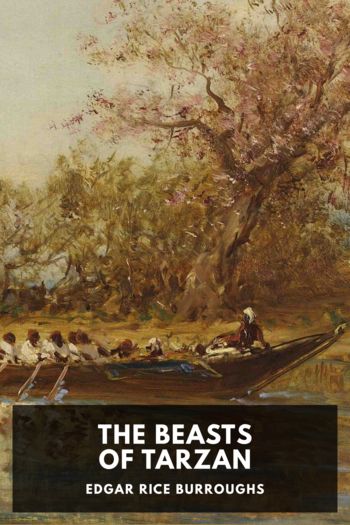Short Fiction, Edgar Allan Poe [best autobiographies to read TXT] 📗

- Author: Edgar Allan Poe
Book online «Short Fiction, Edgar Allan Poe [best autobiographies to read TXT] 📗». Author Edgar Allan Poe
By the following fact, some color was given to the suspicion thus thrown upon Beauvais. A visitor at his office, a few days prior to the girl’s disappearance, and during the absence of its occupant, had observed a rose in the keyhole of the door, and the name “Marie” inscribed upon a slate which hung near at hand.
The general impression, so far as we were enabled to glean it from the newspapers, seemed to be, that Marie had been the victim of a gang of desperadoes—that by these she had been borne across the river, maltreated and murdered. Le Commerciel,37 however, a print of extensive influence, was earnest in combating this popular idea. I quote a passage or two from its columns:
“We are persuaded that pursuit has hitherto been on a false scent, so far as it has been directed to the Barrière du Roule. It is impossible that a person so well known to thousands as this young woman was, should have passed three blocks without someone having seen her; and anyone who saw her would have remembered it, for she interested all who knew her. It was when the streets were full of people, when she went out.
It is impossible that she could have gone to the Barrière du Roule, or to the Rue des Drômes, without being recognized by a dozen persons; yet no one has come forward who saw her outside of her mother’s door, and there is no evidence, except the testimony concerning her expressed intentions, that she did go out at all. Her gown was torn, bound round her, and tied; and by that the body was carried as a bundle. If the murder had been committed at the Barrière du Roule, there would have been no necessity for any such arrangement. The fact that the body was found floating near the Barrière, is no proof as to where it was thrown into the water.
A piece of one of the unfortunate girl’s petticoats, two feet long and one foot wide, was torn out and tied under her chin around the back of her head, probably to prevent screams. This was done by fellows who had no pocket-handkerchief.”
A day or two before the Prefect called upon us, however, some important information reached the police, which seemed to overthrow, at least, the chief portion of Le Commerciel’s argument. Two small boys, sons of a Madame Deluc, while roaming among the woods near the Barrière du Roule, chanced to penetrate a close thicket, within which were three or four large stones, forming a kind of seat, with a back and footstool. On the upper stone lay a white petticoat; on the second, a silk scarf. A parasol, gloves, and a pocket-handkerchief were also here found. The handkerchief bore the name “Marie Rogêt.” Fragments of dress were discovered on the brambles around. The earth was trampled, the bushes were broken, and there was every evidence of a struggle. Between the thicket and the river, the fences were found taken down, and the ground bore evidence of some heavy burden having been dragged along it.
A weekly paper, Le Soleil,38 had the following comments upon this discovery—comments which merely echoed the sentiment of the whole Parisian press:
“The things had all evidently been there at least three or four weeks; they were all mildewed down hard with the action of the rain and stuck together from mildew. The grass had grown around and over some of them. The silk on the parasol was strong, but the threads of it were run together within. The upper part, where it had been doubled and folded, was all mildewed and rotten, and tore on its being opened.
The pieces of her frock torn out by the bushes were about three inches wide and six inches long. One part was the hem of the frock, and it had been mended; the other piece was part of the skirt, not the hem. They looked like strips torn off, and were on the thorn bush, about a foot from the ground.
There can be no doubt, therefore, that the spot of this appalling outrage has been discovered.”
Consequent upon this discovery, new evidence appeared. Madame Deluc testified that she keeps a roadside inn not far from the bank of the river, opposite the Barrière du Roule. The neighborhood is secluded—particularly so. It is the usual Sunday resort of blackguards from the city, who cross the river in boats. About three o’clock, in the afternoon of the Sunday in question, a young girl arrived at the inn, accompanied by a young man of dark complexion. The two remained here for some time. On their departure, they took the road to some thick woods in the vicinity. Madame Deluc’s attention was called to the dress worn by the girl, on account of its resemblance to one worn by a deceased relative. A scarf was particularly noticed. Soon after the departure of the couple, a gang of miscreants made their appearance, behaved boisterously, ate and drank without making payment, followed in the route of the young man and girl, returned to the inn about dusk, and re-crossed the river as if in great haste.
It was soon after dark, upon this same evening, that Madame Deluc, as well as her eldest son, heard the screams of a female in the vicinity of the inn. The screams were violent but brief. Madame D. recognized not only the scarf which was found in the thicket, but the dress which was discovered upon the corpse. An omnibus driver, Valence,39 now also testified that he saw Marie Rogêt cross a ferry on the Seine, on the Sunday in question, in company with a young man of dark complexion. He, Valence, knew Marie, and could not





Comments (0)